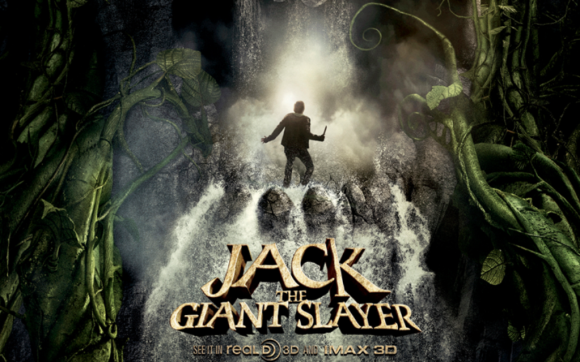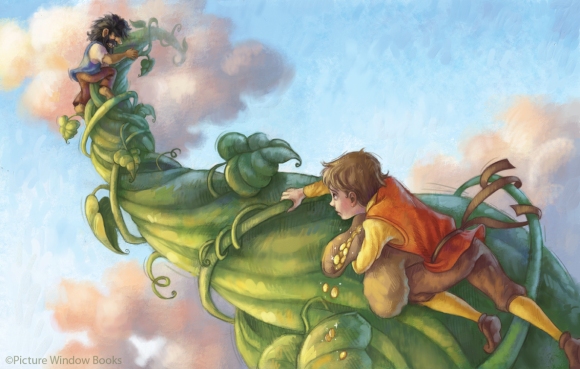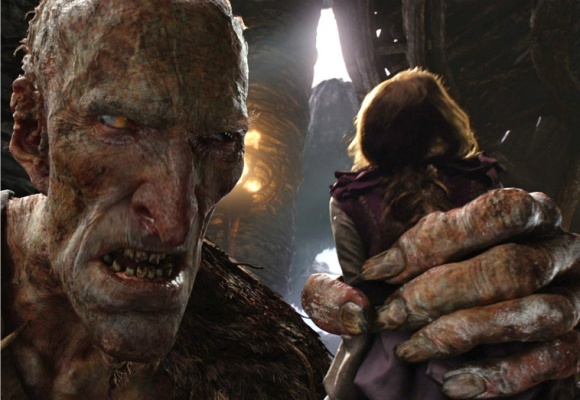 Upon seeing the movie, Jack the Giant Slayer, I became curious about the origins of the story since so many other iterations have shared the same theme.
Upon seeing the movie, Jack the Giant Slayer, I became curious about the origins of the story since so many other iterations have shared the same theme.
- Jack the Giant Killer (1711)
- Jack and the Beanstalk (1807)
- Roald Dahl’s novel BFG (1982)
- Jack the Giant Slayer (2013)
The version I’m most familiar with is Jack and the Beanstalk—an English folktale that closely resembles its predecessor Jack the Giant Killer. As the story goes, Jack is a poor boy living with his widowed mother on their small plot of land. Their only means of income is a cow, which at some point has stopped producing milk. Jack is instructed by his mother to take the cow to the market to sell it, but along the way he encounters an old man who offers to give Jack some magic beans in exchange for the cow.
Jack accepts the offer and returns home to show his mother the beans. His mother is furious and throws the beans out the window and then sends Jack to bed without dinner.
As Jack sleeps, the beans grow into a gigantic beanstalk reaching a land high in the sky. Jack climbs the beanstalk and upon reaching the top discovers a road leading to the home of a giant. Jack enters the house and asks the giant’s wife for some food for his aching belly. The wife gives Jack some food and even hides him when the giant returns home. The giant smells Jack and says:
“Fee-fi-fo-fum!
I smell the blood of an Englishman,
Be he alive, or be he dead,
I’ll have his bones to grind my bread.”
Jack emerges from his hiding spot and escapes down the beanstalk undetected by the giant. However, before leaving Jack steals a bag of gold coins from the giant. Now that I think about it, maybe this is where the slang verb “jack” comes from, which means to steal.
Jack climbs up the beanstalk on two more separate occasions to ‘jack’ some more of the giants’ treasures. The second time, Jack steals a hen that lays golden eggs. The third time he steals a magic harp.
On the third time, Jack is almost caught by the giant, but narrowly escapes down the beanstalk. The giant chases Jack down the beanstalk, but Jack manages to arrive at the bottom first. Jack uses his axe to chop the base of the beanstalk until it falls, causing the giant to plummet to his death. Jack and his mother live happily ever after with their new riches.
According to Wikipedia, the giant is unnamed in the classic version of Jack and the Beanstalk, but then takes on the name Blunderbore—the same name as the giant in Jack the Giant Killer.
This wasn’t the only piece of information on Wikipedia that piqued my interest. Apparently, there are a lot of controversial elements that play out in the seemingly innocent children’s story that had eluded me as a small child and even as an adult.
 In his book, The Uses of Enchantment: The Meaning and Importance of Fairy Tales (1976), Child psychologist Bruno Bettelheim offers a theory that the reason Jack and the giant stories resonate with children so much is that they may perceive “grown-ups” to be scary giants at times. He states that the story teaches children to outsmart the giants and get the better of them.
In his book, The Uses of Enchantment: The Meaning and Importance of Fairy Tales (1976), Child psychologist Bruno Bettelheim offers a theory that the reason Jack and the giant stories resonate with children so much is that they may perceive “grown-ups” to be scary giants at times. He states that the story teaches children to outsmart the giants and get the better of them.
The story is also criticized for its portrayal of Jack being a hero, but deceitfully hiding in the giant’s house, taking advantage of the wife’s sympathies, robbing them, playing a part in the murder of the giant, which leaves the giant’s wife poor and lonely.
Many versions of the story attempt to remedy these problems in the following ways:
- By introducing a fairy, who tells Jack that the giant had robbed and killed his father, henceforth justifying Jack’s actions as retribution.
- Vilifying the giant by having him terrorize humans and obtaining his treasure by unscrupulous means.
- Claiming the hen that lays golden eggs and the harp originally belonged to Jack’s family and Jack was merely retrieving what was rightfully his.
- By having Jack’s mother chop down the beanstalk rather than Jack.
By juxtaposing Jack’s actions to the antagonist, it paints him as a legitimate hero.
Roald Dahl’s version of Jack and the Beanstalk is called The BFG (1982). In Dahl’s story, the giants fear Jack due to his reputation as a giant killer. Again, the giants are portrayed as friendly (as the tittle suggests—Big Friendly Giant) and Jack’s thefts are completely unmotivated and unjustified.
It’s always interesting to revisit something with a different perspective. It’s tough to say if the story is harmful to children since I doubt any of them would ever recognize Jack’s actions as immoral.
Article by Edward Mullen
Author of The Art of the Hustle and Destiny and Free Will
Host of The Edward Mullen Podcast


